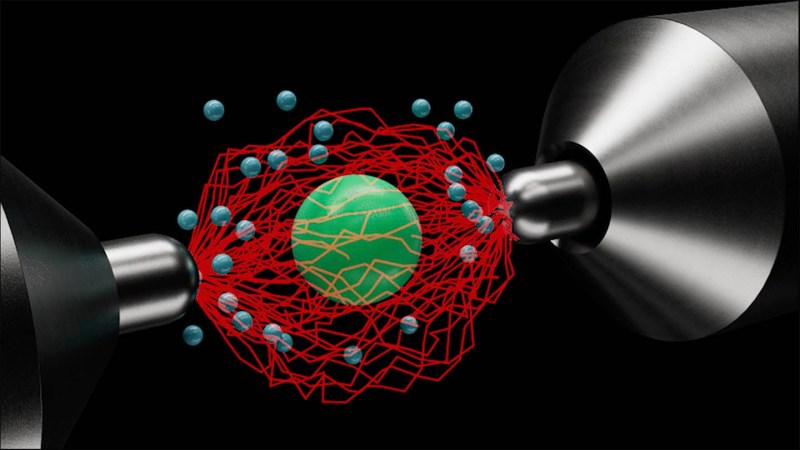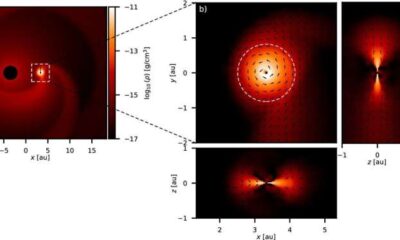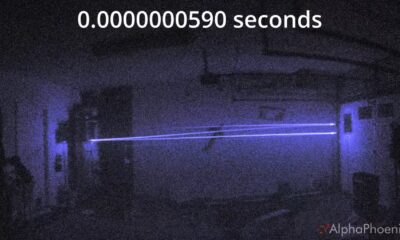Science
Tiny Glass Sphere Achieves Record-Breaking Effective Temperature

A groundbreaking experiment has unveiled a tiny glass sphere that mimics the behavior of an engine operating at extreme temperatures. Researchers have reported that this 5-micrometer-wide sphere, levitated in a near-vacuum using an electric field, reaches an effective temperature equivalent to a staggering 13 million Celsius. This temperature, nearly as hot as the core of the sun, challenges conventional definitions of an engine.
The findings, published in Physical Review Letters, indicate that despite its extreme effective temperature, touching the glass sphere would not cause burns. The temperature arises from the sphere’s overall motion rather than the kinetic energy of its individual atoms, which is how temperature is typically measured. According to James Millen, a physicist at King’s College London and coauthor of the study, “It is moving as if you had put this object into a gas that was that hot. It moves around like crazy.”
Understanding the mechanics of this tiny engine is significant for the broader field of thermodynamics, which deals with heat and energy. The sphere operates as a heat engine, a device that converts heat into mechanical work by absorbing heat from a high-temperature source and expelling waste heat to a cooler sink. The ratio of hot to cold temperatures directly influences the efficiency of such engines, and the researchers found that this micro-engine boasts a remarkable ratio of about 100, far exceeding the typical efficiency of commercial engines, which averages around 3.
Insights into Microscopic Physics
The research team observed fascinating fluctuations in the engine’s performance. Efficiency varied widely, with measurements ranging from 10 percent to an astonishing 200 percent. There were even instances where the engine appeared to cool down instead of heating up. “Thermodynamics down at the microscale is really, really weird,” Millen noted. “I really think it’s as unintuitive as something like quantum mechanics.”
This discovery holds potential implications for the understanding of biological processes at the microscopic level. The behavior of this glass sphere mirrors the dynamics of minute structures, such as proteins, which are continuously affected by random movements in their surroundings. The researchers aim to leverage this engine to study biological motors like kinesin, which transport cargo within cells.
While the glass sphere does not function as a conventional engine, Millen emphasizes its value as an experimental tool. “No one would really say, ‘Vroom vroom, that’s an engine,’” he remarked. Instead, it serves as a perfect analog for scientists to explore the principles governing tiny engines.
One intriguing aspect of the experiment involves position-dependent diffusion, a phenomenon that alters the effective temperature experienced by the particle as it moves within the electric field. This principle is crucial for understanding biological mechanisms, including protein folding, which can significantly impact cellular functions.
Future Directions in Engine Research
Uroš Delić from TU Wien, who was not involved in the research, highlighted the significance of combining extreme temperature, a large hot-to-cold temperature ratio, and position-dependent diffusion into a single experiment. “Creating an engine with a single one of these attributes would make for a nice experiment,” he stated. “This work combines all three, so that’s quite cool — or hot.”
The findings from this innovative study open avenues for further research into the behavior of engines at micro and nanoscale levels. As scientists continue to unravel these complex dynamics, a deeper understanding of thermodynamics at such small scales could eventually lead to advancements in both technology and biology, paving the way for new applications in various fields.
-

 Science2 months ago
Science2 months agoOhio State Study Uncovers Brain Connectivity and Function Links
-

 Politics2 months ago
Politics2 months agoHamas Chief Stresses Disarmament Tied to Occupation’s End
-

 Science1 month ago
Science1 month agoUniversity of Hawaiʻi Joins $25.6M AI Project for Disaster Monitoring
-

 Science4 weeks ago
Science4 weeks agoALMA Discovers Companion Orbiting Giant Star π 1 Gruis
-

 Entertainment2 months ago
Entertainment2 months agoMegan Thee Stallion Exposes Alleged Online Attack by Bots
-

 Science2 months ago
Science2 months agoResearchers Challenge 200-Year-Old Physics Principle with Atomic Engines
-

 Entertainment2 months ago
Entertainment2 months agoPaloma Elsesser Shines at LA Event with Iconic Slicked-Back Bun
-

 World1 month ago
World1 month agoFDA Unveils Plan to Cut Drug Prices and Boost Biosimilars
-

 Business2 months ago
Business2 months agoMotley Fool Wealth Management Reduces Medtronic Holdings by 14.7%
-

 Science2 months ago
Science2 months agoInnovator Captures Light at 2 Billion Frames Per Second
-

 Top Stories2 months ago
Top Stories2 months agoFederal Agents Detain Driver in Addison; Protests Erupt Immediately
-

 Entertainment1 month ago
Entertainment1 month agoBeloved Artist and Community Leader Gloria Rosencrants Passes Away









